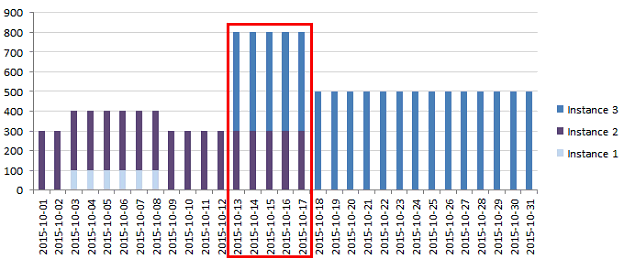Understanding CSV files with metric utilization
Due to differences in the structure of the user interface reports and CSV reports, information about metric utilization is presented differently in each type of report. Learn more about these differences to better understand how to correlate the information between user interface reports and CSV reports.
Multilevel versus flat report structure
- First level - a list of all products.

- Second level - when you click a product name, you go to information about the physical server on
which the product is installed.

- Third level - when you click the server name, you go to the list of virtual machines that run on
this server and have the product installed.

The audit snapshot is not multilevel. However, it must present the same information that the report that is available in the user interface. Below is an excerpt from the audit snapshot that corresponds to the report presented on the screen captures above. Some columns are hidden in the snapshot to simplify it.
| D | E | F | H | K | M | N | O | P | S |
|---|---|---|---|---|---|---|---|---|---|
| Product Name | Metric Quantity | Metric Peak Value Time | Server Name | PVU Per Core | Physical Server CPU Core Subcapacity Limit | Physical Server CPU Core Subcapacity | Physical Server PVU Subcapacity Limit | Physical Server PVU Subcapacity | Computer |
| IBM MQ | 810 | 2016-06-01 00:00:00.000 | X.XXX.XX.217 | 70 | 8 | 3 | 560 | 210 | Computer 1 |
| IBM MQ | 810 | 2016-06-01 00:00:00.000 | X.XXX.XX.217 | 70 | 8 | 3 | 560 | 210 | Computer 2 |
| IBM MQ | 810 | 2016-06-01 00:00:00.000 | X.XXX.XX.217 | 70 | 8 | 3 | 560 | 210 | Computer 3 |
When values in column O (Physical Server PVU Subcapacity Limit) are added, PVU consumption equals 1680 PVUs, which is greater than the value that is presented on the user interface. These values should not be added because they all refer to a single server (X.XXX.XX.217) on which the three VMs run, not an individual VM that is listed in column S (Computer). The value in column M is repeated due to the flat structure of the CSV report.
- Column O in the CSV report relates to the PVU Subcapacity Limit column on the second level of the report
- Column N in the CSV report relates to the CPU Core Subcapacity column on the second level of the report

PVU and RVU MAPC subcapacity license terms specify license consumption only on the physical server level. The values cannot be calculated and presented on the virtual machine or LPAR level, and such data is not provided by BigFix Inventory. For more information, see: Virtualization Capacity License Counting Rules.
CSV reports contain only software instances discovered during the license peak value time
CSV reports list only software instances that were discovered during the license peak value time. If an instance was installed in your environment during the reporting period but was not discovered during the license peak value time, the instance is not listed in the CSV reports.
- Instance 1 uses the maximum of 100 PVUs
- Instance 2 uses the maximum of 300 PVUs
- Instance 3 uses the maximum of 500 PVUs

The license peak value occurs when the sum of PVU values for all instances is the highest and equals 800 PVUs (300 PVUs for instance 2 + 500 PVUs for instance 3). The peak occurs during the period that is marked with a red square. It is the license peak value time. The peak usage for instance 1 is outside of the peak value time. It means that this instance was installed in the environment during the current reporting period but was not discovered during the license peak value time. This instance is not listed in the CSV report.